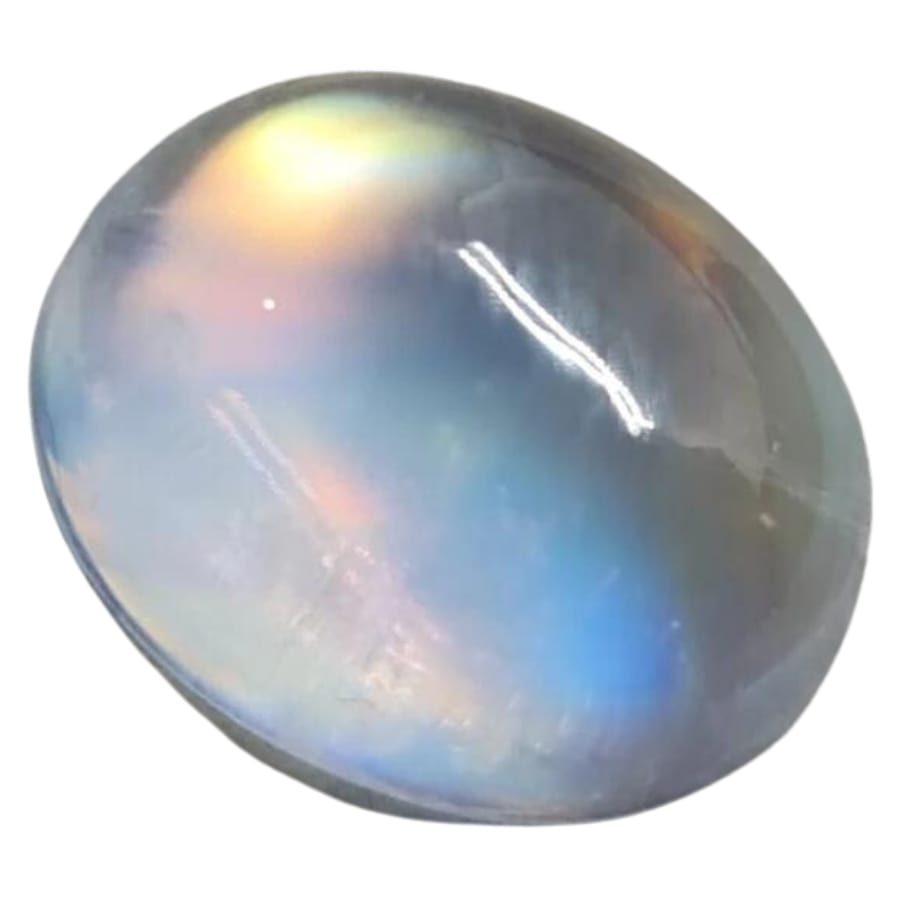Moonstone and labradorite are magnificent gemstones that catch our attention with their mysterious looks and unique glows. Their rainbow of colors and unique properties make them stand out in the world of gemstones.
Moonstone has a soft, moonlike sheen, and labradorite is known for its bright, colorful shimmer. These two minerals are related, but not very closely. They were formed in the deepest parts of the earth and come from different parts of the world.
This article will take you through the fascinating worlds of moonstone and labradorite. We’re going to discover their secrets and how they are alike and different in ways that may surprise you!
Get ready to become a gemstone detective as we decode the mysteries and marvels of moonstone and labradorite!
Moonstone vs. Labradorite – The Major Differences
Even though moonstone and labradorite are both very beautiful, a few big differences between them will help you tell them apart. These are the things that make them different:
Appearance – Labradorite displays labradorescence
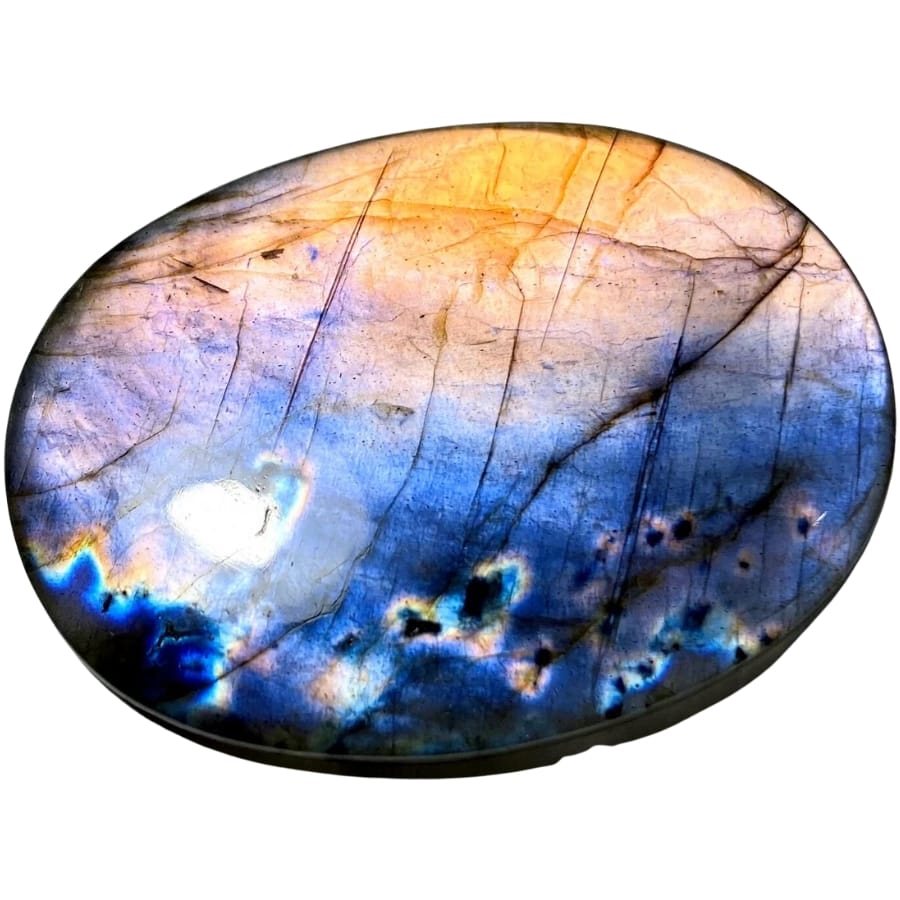
The most noticeable difference between moonstone and labradorite is the way they look. These are called adularescence and labradorescence, respectively.
Adularescence, a soft, glowing sheen that seems to billow across the stone’s surface and looks like the moonlight, makes moonstone so beautiful.
For this effect to happen, light has to hit thin layers of different feldspar minerals inside the stone and bounce around. The most sought-after moonstones have a blue sheen that dances over a transparent or white background.
Labradorite shines with amazing labradorescence, a bright play of color that changes into a kaleidoscopic show of blue, green, gold, or even rainbow colors, depending on how it’s looked at.
The brilliant effect comes from light bouncing around the stone’s complicated lamellar structure. Labradorite’s beauty is more lively and dramatic than moonstone’s, which has a calm, almost otherworldly glow.
Chemical Composition – Moonstone is made up of potassium aluminum silicate
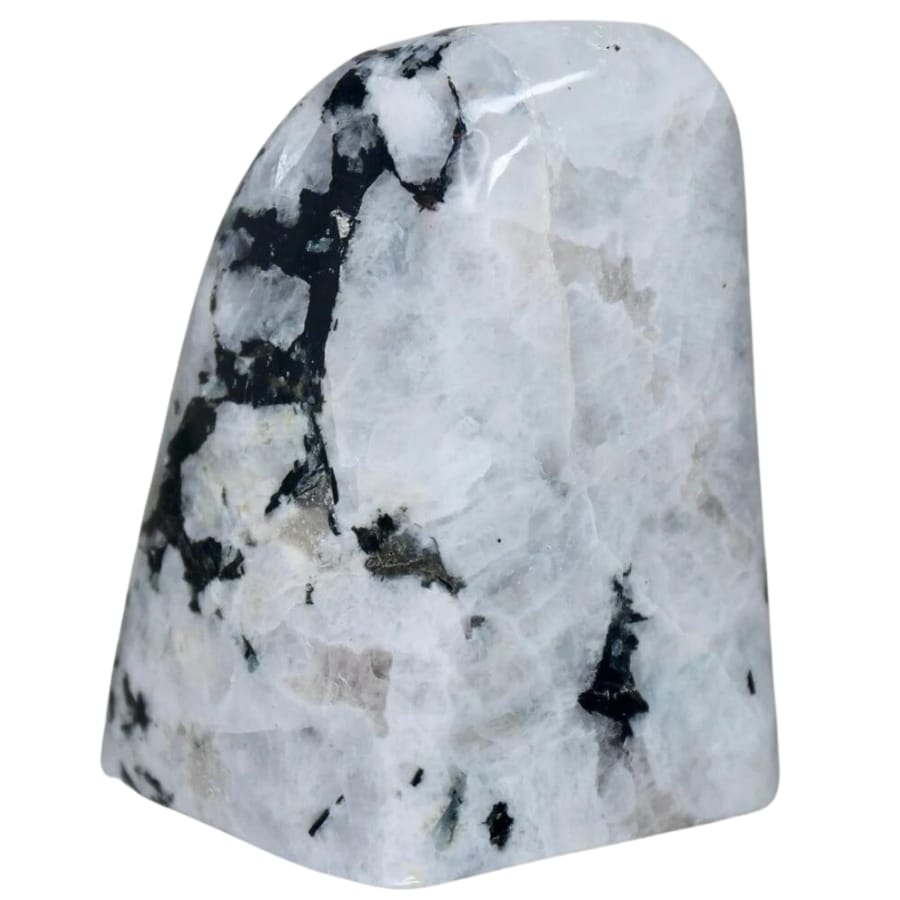
Even though both moonstone and labradorite are feldspar minerals, they have different chemical make-ups that give them unique qualities. Moonstone is mostly made up of potassium aluminum silicate.
Its chemical formula is (K,Na)AlSiO₈, which means it has potassium (K) and sodium (Na) in it (Na). There are two types of feldspar in it: orthoclase and albite, which are layered on top of each other.
This layered structure is a key part of the stone’s unique adularescence.
Labradorite is a type of plagioclase feldspar. Its chemical make-up is (Ca,Na)(Al, Si)AlSiO₈, where Ca and Na are calcium ions and Al and Si are silicon ions (Si).
The unique color play, called labradorescence, happens because light is bent in the microscopic layers inside the stone. This is because the stone’s lamellar structure comprises different types of materials.
This structure is mainly caused by sodium and calcium mixing, creating a complex web of interactions between these elements inside the mineral.
Color – Labradorite’s base color is dark gray or black
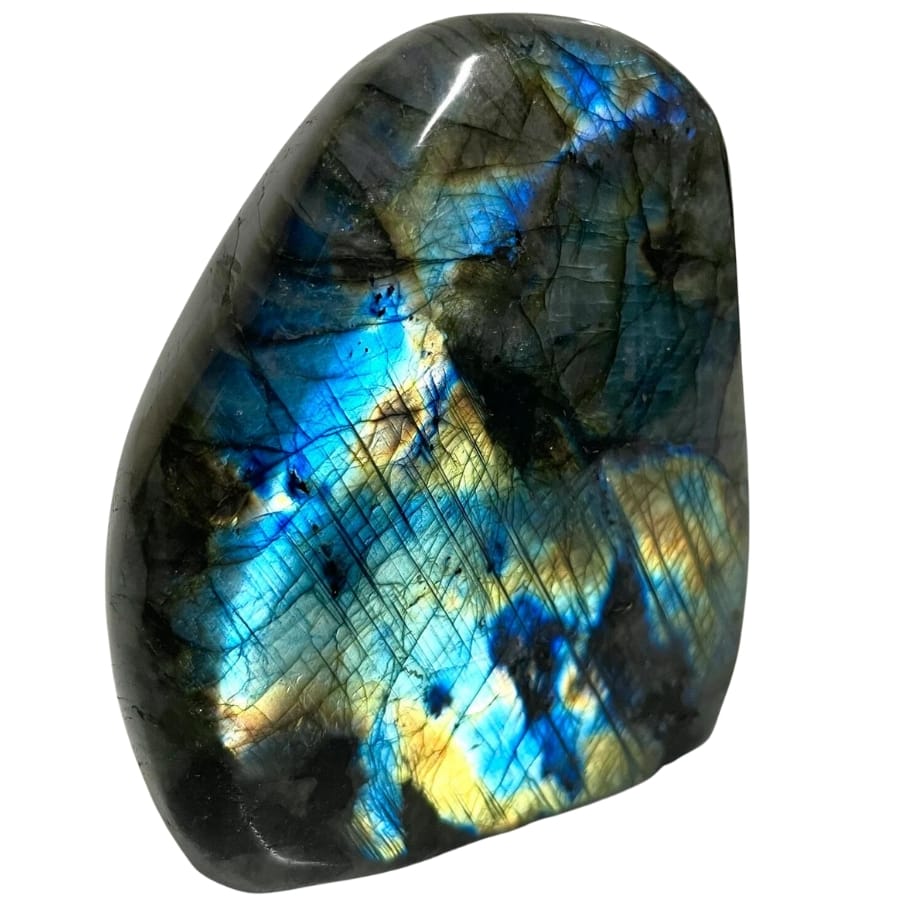
Moonstone and labradorite come in a wide range of beautiful colors, each with unique appeal. Moonstone has a color that resembles moonlight, which is how it got its name.
People usually think of moonstone as a clear, ethereal blue color because its surface shines and seems to glide over other things. That said, moonstones can be colorless, white, gray, green, pink, or brown, and their surfaces can sometimes look like a cat’s eye or a star.
How clear and colored the sheen of a moonstone is often linked to how much it’s worth. A clear blue moonstone on a colorless background is the most valuable.
Labradorite is famous for the amazing range of colors it shows off through a phenomenon called labradorescence. While the stone is usually a dark gray to black color, it shimmers with a beautiful play of colors when it catches the light.
Many shades of blue, green, and yellow can be found here, as well as orange, red, and even violet. The more intense and vivid the color spectrum for labradorite, the better it is.
This beautiful iridescence is caused by light waves bouncing off of the stone’s twinned surfaces. The colors often change depending on the angle from which the stone is looked at.
Labradorite has a much more dramatic and varied display of color than moonstone, which has a soft, peaceful glow.
Density – Moonstone has a slightly lower density
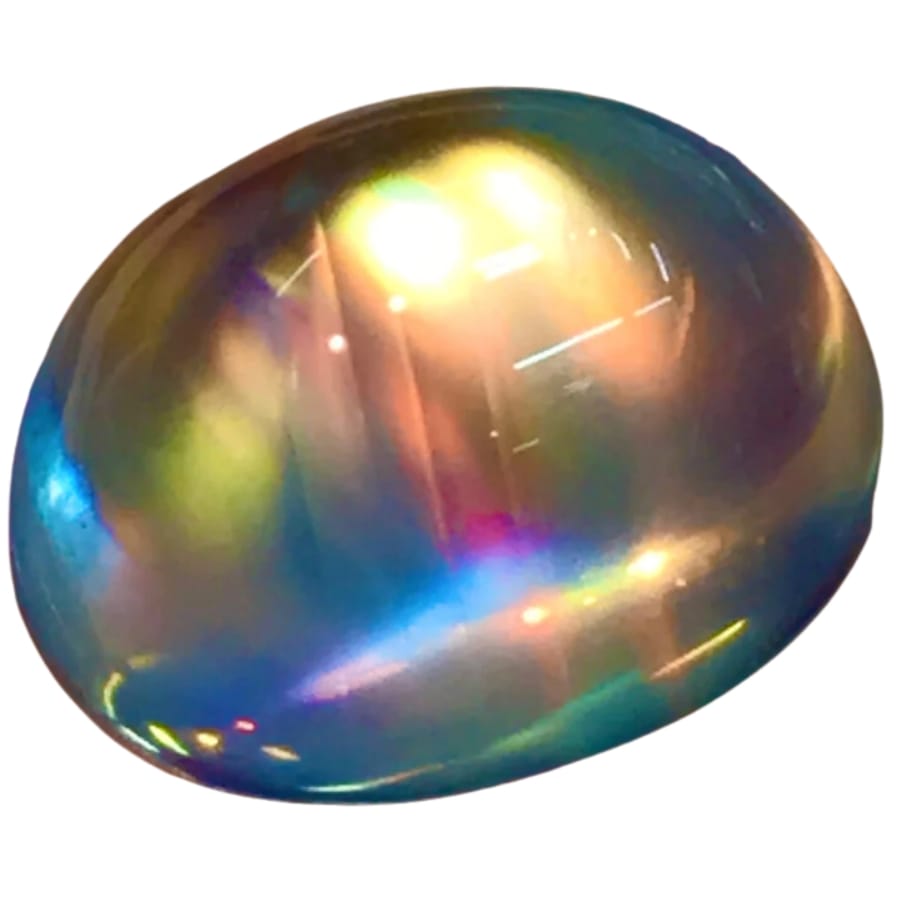
Density, a substance’s mass per unit volume, differs for each mineral and is very important for telling them apart, especially in gems like moonstone and labradorite.
Moonstone has a lower density, usually between 2.56 and 2.59 g/cm³. The fact that it’s mostly made up of potassium aluminum silicate and has a crystalline structure explains its relatively low density.
Its density is based on how the atoms are arranged inside and the presence of different elements. These factors affect the mass and volume of the substance as a whole.
Labradorite has a slightly higher density, between 2.68 and 2.72 g/cm³. This rise is due to its unique make-up, a sodium and calcium aluminum silicate mix. Labradorite is denser than moonstone because it contains calcium, a heavier element than potassium.
Although both minerals are feldspars, there are differences in their chemical composition and molecular structure that directly affect their densities.
Price – Labradorite is less expensive
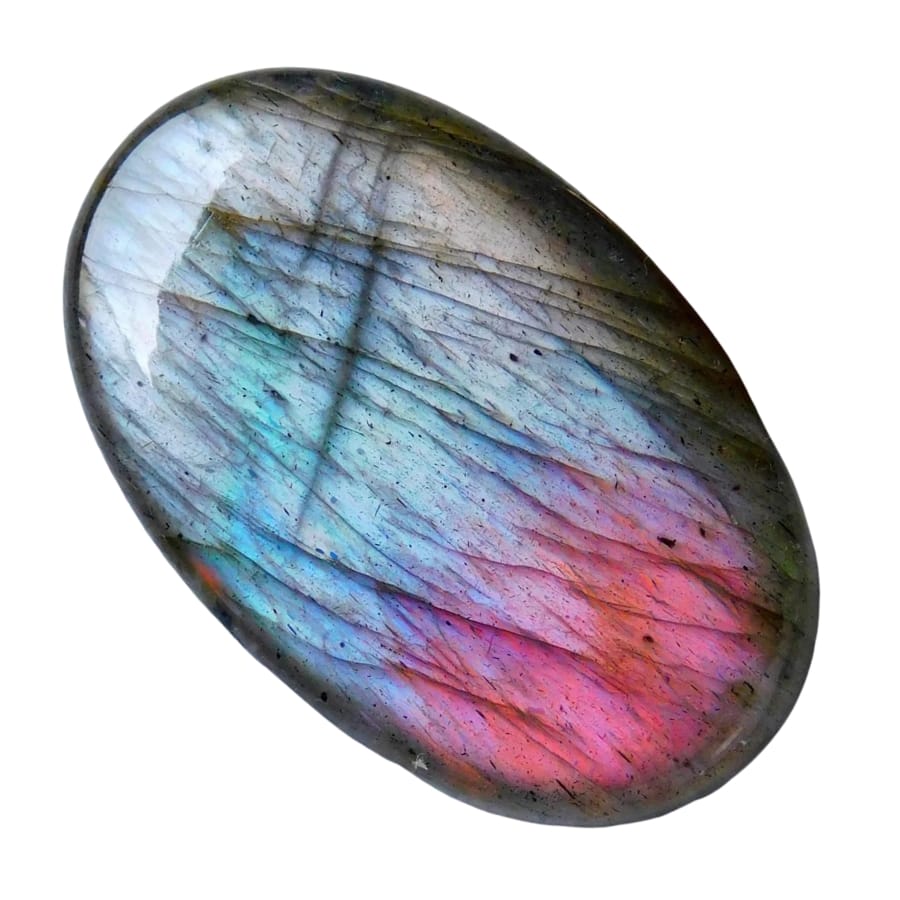
Gemstones like moonstone and labradorite are priced based on their rarity, color, clarity, and overall quality, among other things.
Minerals like moonstone and labradorite can be pretty cheap, but some features can make certain pieces much more expensive.
The most valuable type of moonstone is blue sheen moonstone, especially those that have a strong, clear adularescence on a background that is colorless or almost colorless.
People are willing to pay more for these stones on the market, especially if they are clear and have no flaws or inclusions. Moonstones that look like a cat’s eye or a star are rare and can be worth a lot of money.
On the other hand, Labradorite’s price is mostly based on how well it shows labradorescence. The most valuable labradorite is spectrolite, a high-quality labradorite that shows a wide range of bright colors.
The more vivid and bright the colors are, the more valuable the stone is. Labradorites with a full spectrum of rainbow colors or intense orange and purple can also fetch higher prices.
Labradorite vs. Moonstone – The Similarities
While moonstone and labradorite are very different, they are also very similar in some interesting ways. If someone only knows these gems by their looks, these traits they share might surprise them.
Cleavage – Both Moonstone and Labradorite have perfect cleavage
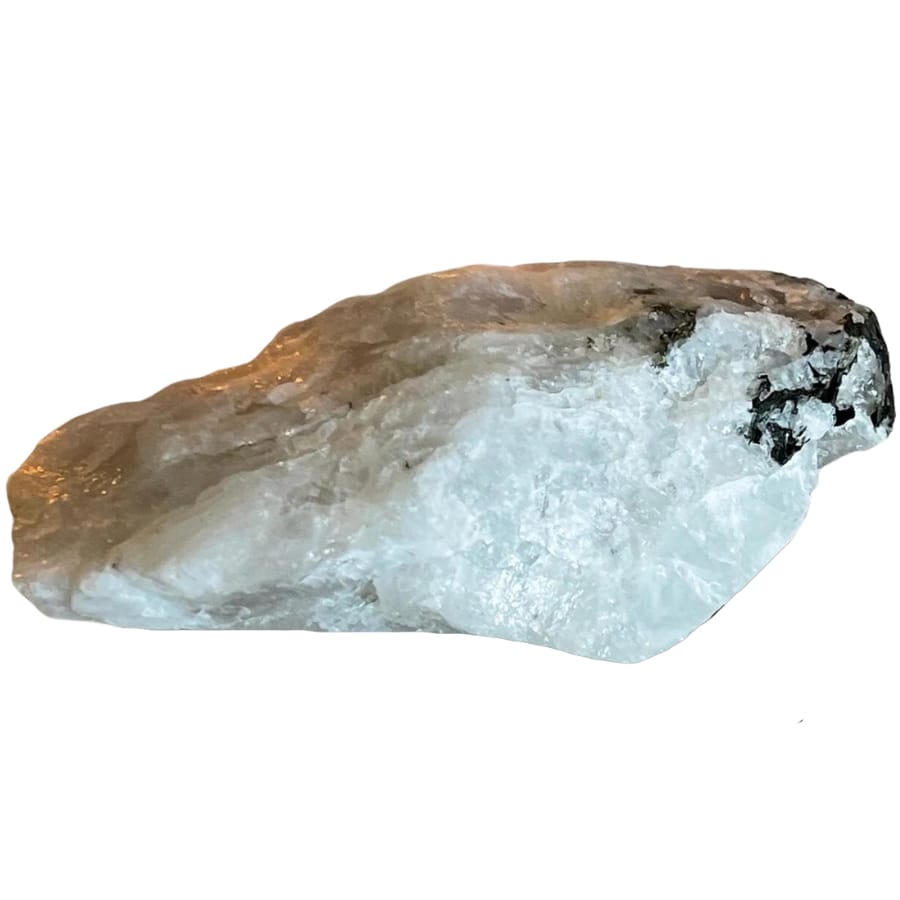
Cleavage is when a mineral breaks along smooth planes because of how its crystals are arranged inside.
Mineralogists use “perfect cleavage” to describe the clean, smooth break that makes flat surfaces. Both of these gemstones have this quality, which is typical of feldspars.
In particular, moonstone only has one direction of perfect cleavage. In other words, if you put force or pressure on it, it’s likely to break cleanly along a certain weak point in its crystalline structure.
Gem cutters need to know about this trait because it affects how they should cut and handle a stone so that it doesn’t break accidentally. They break apart similarly for moonstone and labradorite, which are both feldspar minerals.
Labradorite has perfect cleavage, but it does so in two directions. This means that it can split along two weak points. The angles between these planes are about 90 degrees.
This property is also very important when cutting labradorite since its value depends on how well its labradorescence shows up, which can only be seen at certain angles to the directions of the cuts.
Conductivity – Neither Labradorite nor Moonstone are good electricity conductors
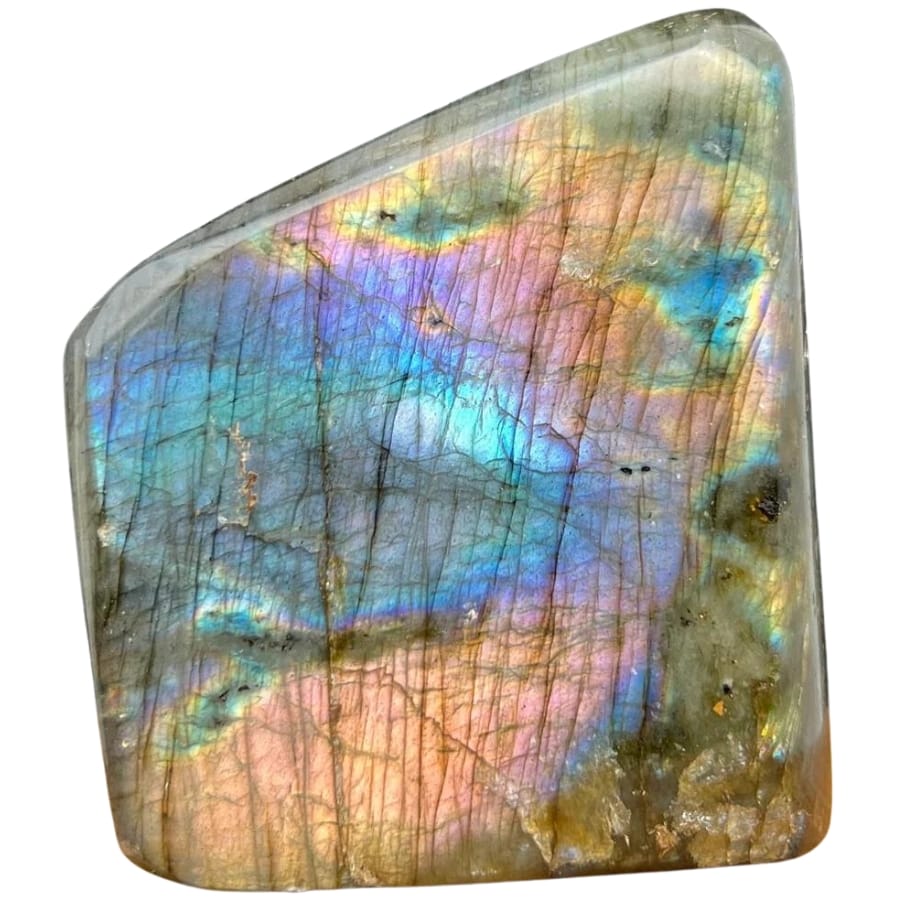
Because both moonstone and labradorite are silicate minerals, they conduct electricity similarly. In general, neither of these gemstones is very good at carrying electricity.
They have this property because they are made up of crystals and chemicals that don’t let electrons flow freely. Regarding minerals, silicates like moonstone and labradorite keep electricity from moving.
In other words, they have a very high resistance to electricity moving through them, which means they have a very low electrical conductivity.
The way their atoms are arranged gives them this insulating property. Strong covalent bonds hold the atoms in these minerals together tightly. The network has no free electrons or ions to carry an electric charge.
This is common in silicate minerals, where the silicon and oxygen make a tetrahedral structure that doesn’t allow for good conductivity.
Another thing that matters is how pure the gemstones are. Moonstone and labradorite are insulators when they are completely pure.
However, impurities or flaws in the crystal lattice, like water or metallic ions, might slightly change how well they conduct electricity.
Still, this effect isn’t very noticeable most of the time, and both moonstone and labradorite are still not conductive in real life.
Formation – Moonstone and Labradorite are both found in igneous settings
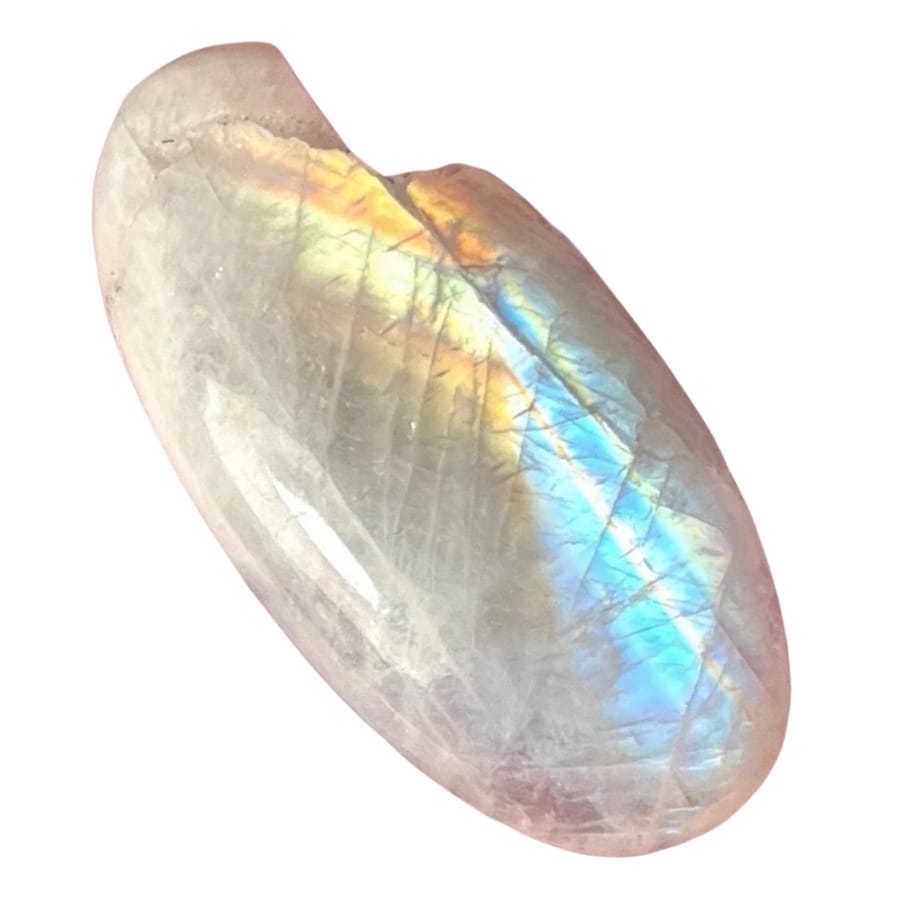
As feldspar minerals, moonstone and labradorite were formed in similar ways. In igneous environments, where molten rock (magma) cools and hardens, these two gemstones are mostly formed.
Slow cooling of magma below the Earth’s surface lets bigger crystals form, which is what happens with these minerals.
Crystals like moonstone and labradorite have unique looks because they cool slowly, which separates the minerals into different layers.
In addition, these minerals can be found in metamorphic rocks, formed when one type of rock changes into another through metamorphism, which means “change in form.”
Higher temperatures and pressure change the original rock’s structure and/or chemistry in important ways. Feldspar minerals are often found in these rocks because they stay stable at high temperatures.
Fluorescence – Both Labradorite and Moonstone lack fluorescence
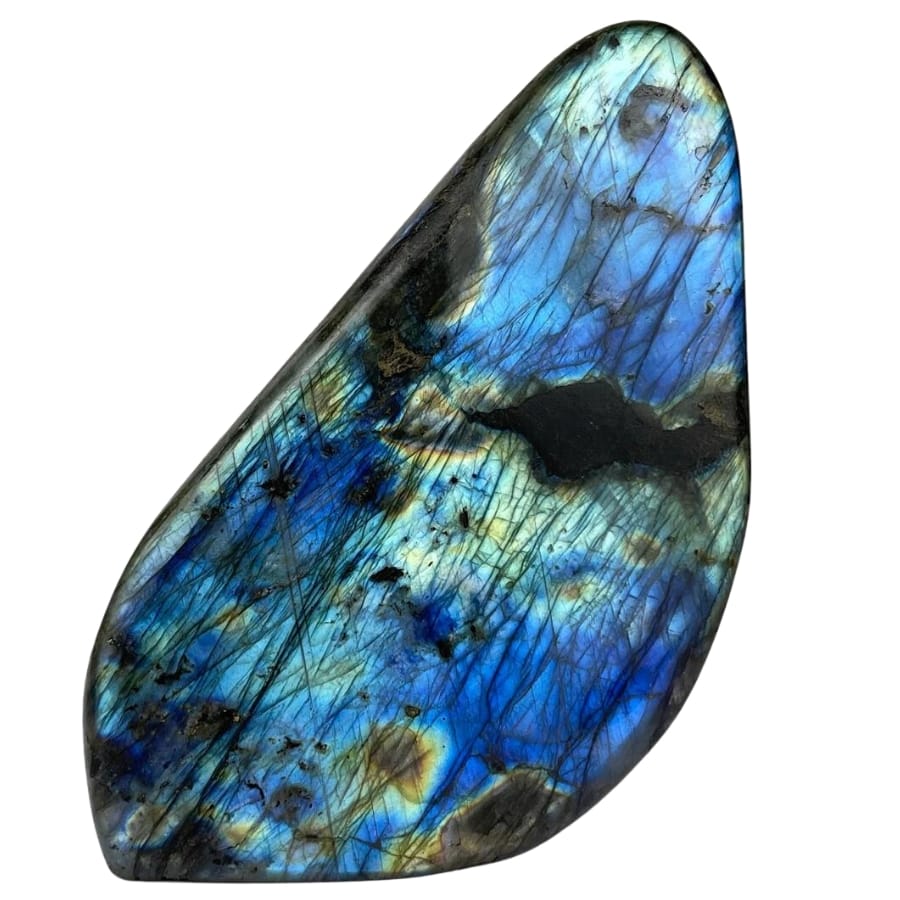
When minerals are exposed to ultraviolet (UV) radiation, they can give off visible light. This is called fluorescence. It’s common for feldspar minerals, like moonstone and labradorite, to have little to no fluorescence.
This means that when exposed to UV light, they don’t usually glow or show colors very different from how they look in regular light. This makes them different from minerals known to have fluorescent solid properties.
Moonstone and labradorite don’t fluoresce because of the chemicals they are made of and how their atoms are arranged in their crystal structures. When a substance takes in UV light and then gives off visible light, this is called fluorescence.
In this process, electrons are excited to a higher energy level and then return to their original state, giving off energy in the form of light.
But how the atoms are arranged and bonded in moonstone and labradorite doesn’t allow this energy to be taken in and given off.
Hardness – Moonstone and Labradorite both rank in 6 – 6.5 on the Mohs scale
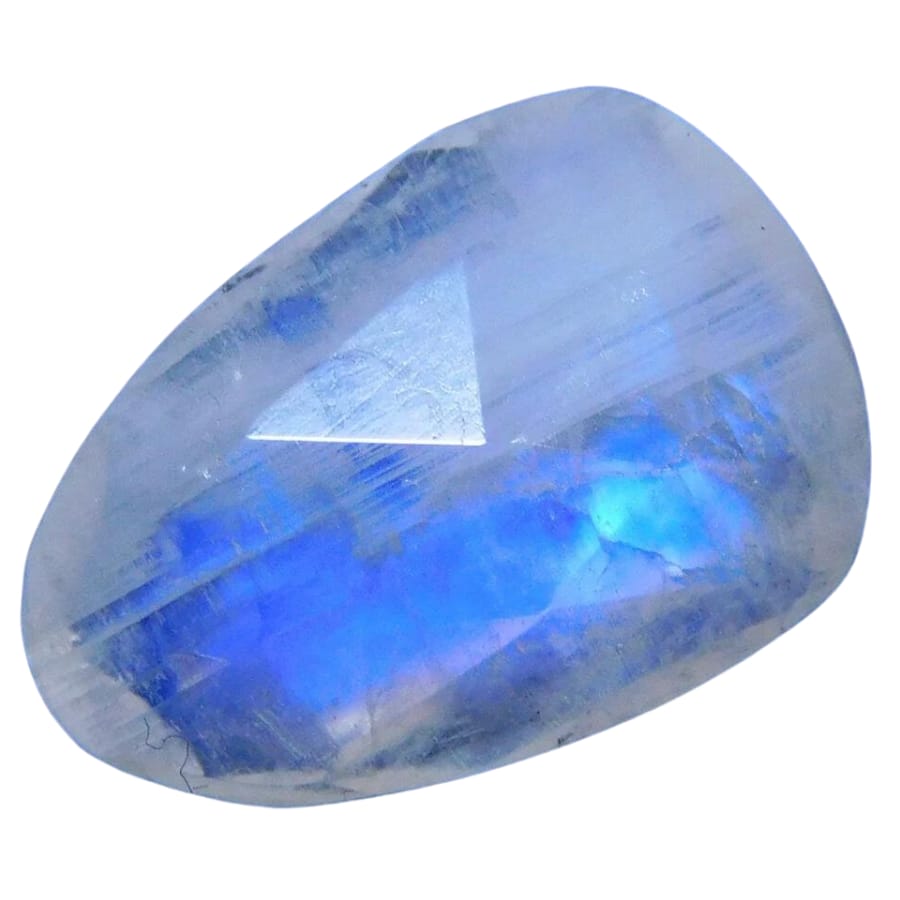
Both moonstone and labradorite are feldspars, which means they are in the same mineral family and have similar hardness levels. Minerals are hard if they can’t be scratched.
The Mohs scale, which goes from 1 (talc) to 10 (rubber), is often used to measure hardness (diamond). Moonstone and labradorite are both in the moderate range of this scale.
The hardness of moonstone is usually between 6 and 6.5, and the hardness of labradorite is slightly higher, at around 6 to 6.5. The structural makeup and chemical bonds within their crystalline structures are what make them hard in similar ways.
This hardness means that both stones are scratch-proof compared to softer minerals but are not as hard as rubies or diamonds.
So, moonstone and labradorite should be handled with care when used in jewelry or other places where they might be exposed to rough surfaces or materials that are likely to scratch or damage them.
Location – Labradorite and Moonstone can be found worldwide
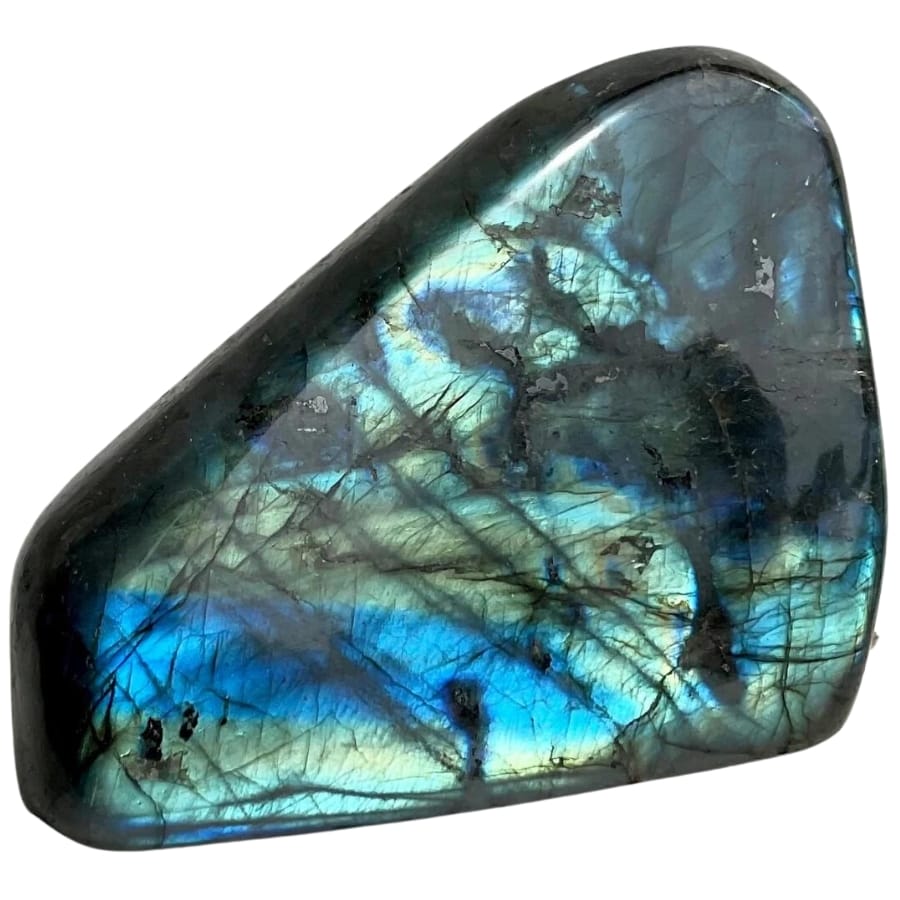
These rocks have histories that can be learned from where you find them. They are the best places to go rockhounding because you can find labradorite and moonstone.
Moonstone and labradorite are both feldspar minerals, which means they are found in similar geological formation conditions in several places worldwide.
These minerals are found in igneous and metamorphic rocks, which are common in many of the same places worldwide.
Moonstones can be found worldwide, but Sri Lanka is known for its high-quality blue-sheen moonstones.
The United States, India, Madagascar, and Myanmar are important sources. These spots are known for having large amounts of feldspar, making them ideal for forming moonstones.
Labradorite, named after Labrador, Canada, where it was first found, can also be found in many other places worldwide.
Besides Canada, labradorite comes from Madagascar, Russia, Mexico, the US, and Finland. The labradorite from Finland is called Spectrolite because it comes in so many colors.
Luster – Moonstone and Labradorite both have vitreous to pearly luster
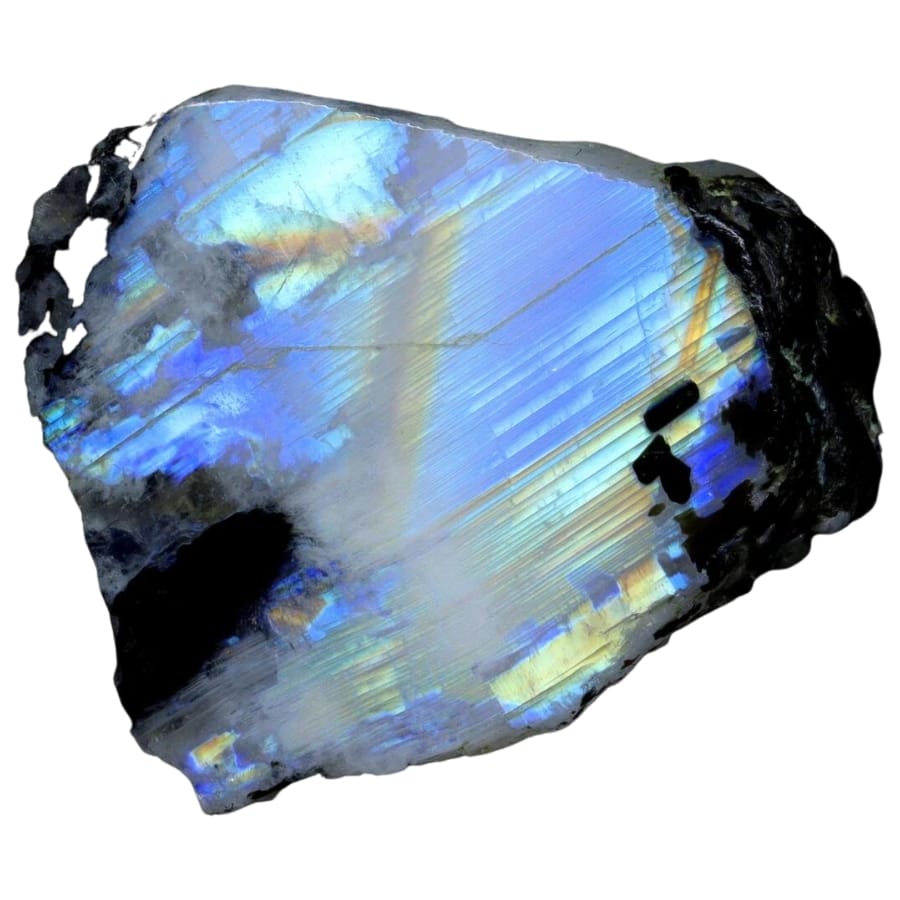
Gemstones like moonstone and labradorite look different but have the same kind of shine. Luster is how light interacts with the surface of a mineral. For these two stones, vitreous to pearly gloss is a common way to describe their luster.
This means that moonstone and labradorite have a shine that looks like glass (vitreous) or a pearl (pearly), especially where the crystals are cut.
The vitreous luster of moonstone and labradorite is most noticeable when the stones are polished. This gives them a nice, shiny, glass-like look.
The luster can appear more pearl-like on raw or natural crystal surfaces, particularly those that exhibit cleavage or have aged over time. This pearly sheen is especially noticeable in moonstones, which helps them look soft and sometimes almost ethereal.
The unique way that light plays off of these stones, called adularescence in moonstone and labradorescence in labradorite, is not the same thing as their shine, but it works with it to make the stones look nice.
Light reflects off of their insides because these gemstones have layered or lamellar internal structures. This interaction between light and the crystal structure makes these gemstones shimmer.
Magnetic – Both Labradorite and Moonstone do not exhibit magnetism
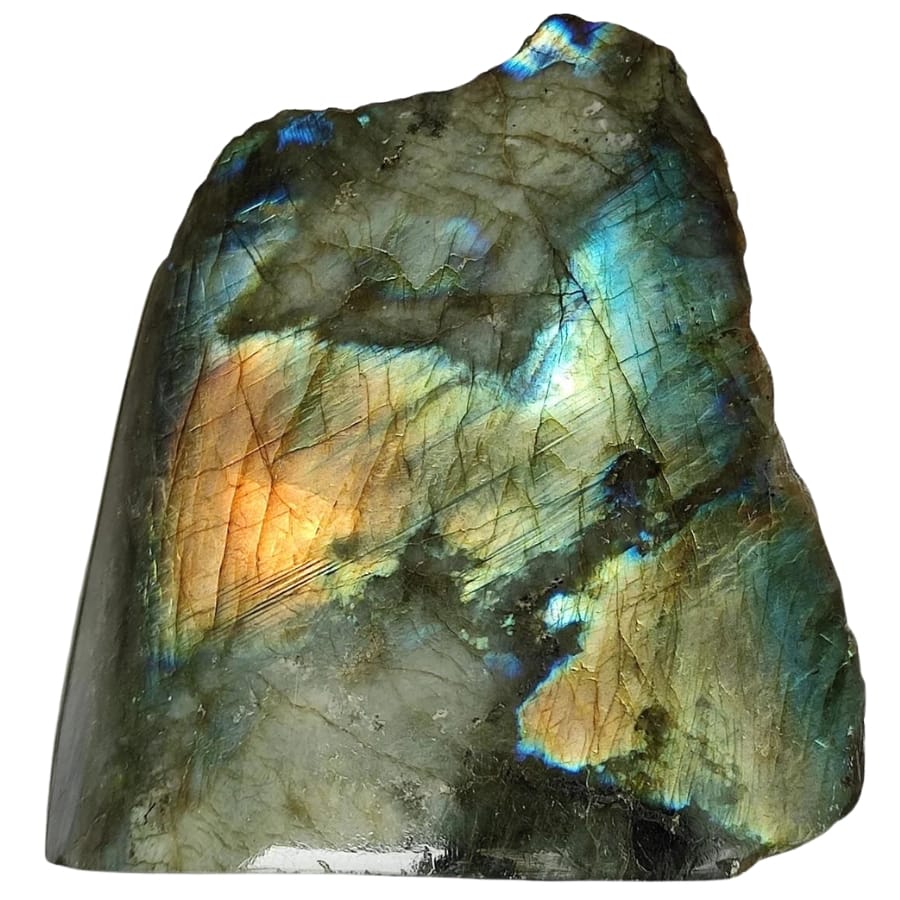
In terms of magnetism, moonstone and labradorite are very similar. This is because they are both essentially non-magnetic.
When a magnetic field is put on a mineral, it responds by either being attracted to the source of the field (ferromagnetism) or being pushed away from it (antiferromagnetism) (diamagnetism).
However, most minerals, like moonstone and labradorite, don’t react to a magnetic field when things are normal. This means they are either paramagnetic or diamagnetic, with low magnetic susceptibility.
Because of how their chemicals are made, moonstone and labradorite don’t react to magnets. These are silicate minerals with few ferromagnetic materials (like iron in its ferrous or ferric state) or unpaired electrons by nature. This means they don’t have a strong magnetic response.
Even though both minerals have iron, the iron in them is not concentrated or in a form that makes them ferromagnetic. The iron is stuck in the silicate structure of the minerals, and the electrons in that structure are arranged in a way that doesn’t allow for a magnetic field.
It’s also important to remember that minerals can be magnetic even if they contain iron. The iron must be in a certain oxidation state and environment to be ferromagnetic, which is not true in moonstone or labradorite.
Streak – Moonstone and Labradorite have colorless streaks

One important way to identify minerals is by their streak, the color of their powdered form when dragged across a streak plate, an unglazed porcelain plate.
Scientists have found that moonstones and labradorites leave a white or colorless streak in water. This is true even though these stones can show different colors when solid because of different optical effects or impurities.
The lack of color in the streaks of these minerals is due to the chemicals that make them up. Both moonstone and labradorite are made up of complex silicates that don’t have a color of their own.
The presence of other trace elements or, more importantly, how light interacts with their structures typically causes the colors we see.
The white or colorless streak shows that the minerals don’t have any colored compounds in their basic makeup. Also, when the minerals are ground up into a fine powder, no color-causing elements stand out.
It’s essential to tell the difference between the color of the mineral in the specimen and the color of the streak of the mineral.
The fact that their streaks are a similar color shows that they are both feldspar, which means they share some fundamental properties even though they are very different.
The Easiest Ways To Tell Moonstone and Labradorite Apart
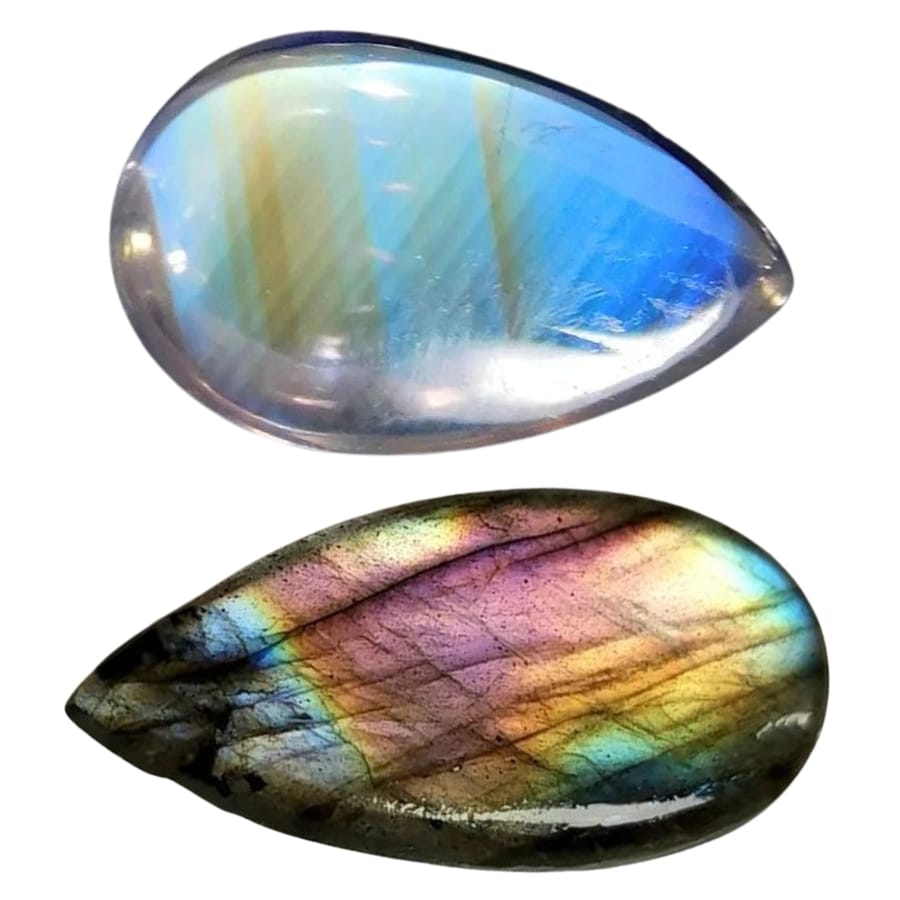
For those who want to buy one, knowing the difference between a moonstone and labradorite is helpful. You can figure out which is which in a few different ways.
Observe the colors
Moonstone is known for its strange glow, which can be blue or white and looks like the moon’s surface. Somewhat like a moon, this glow moves when you turn the stone. Adularescence is the name for this effect.
While labradorite can be blue, green, yellow, orange, or pink, it doesn’t just show one color. This show of colors is called labradorescence. It’s almost like the stone has its light show. The stone you’re holding is probably labradorite if it has a lot of different colors.
Check the appearance
Moonstone has a more transparent to translucent look. This means you might be able to see through it if it’s a very thin slice, or it might just let a bit of light through, giving it a dreamy appearance.
However, Labradorite is typically more opaque, which means you can’t see through it, and it can sometimes look dull or dark when it’s not catching the light.
Inspect the shape of the stone
Moonstone is often found in smoother, rounded shapes or cut in a cabochon style, like a smooth, rounded dome. This shape helps to enhance the stone’s glow.
Labradorite, however, is often found in irregular shapes or as flat, polished pieces that show off those exciting colors.

